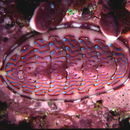pt-BR
nomes no trilho de navegação


Tonicella lineata, die Lined Chiton, ist eine Art der Käferschnecken aus dem Nordpazifik.
Tonicella lineata ist eine sehr bunte Käferschnecke. Die Schale mit acht Einzelplatten ist mit blauen, violetten oder schwarzen geraden oder Zickzack-Linien geschmückt. Die Hintergrundfarbe der so genannten Valven ist oft Braun oder Rot, kann aber ebenso strahlend Blau, oder Gelb bis Orange sein. Der Gürtel (Perinotum) ist unbehaart und braun bis rot oder pink, oft mit regelmäßigen gelben oder weißen Flecken. Die Art erreicht eine Länge von bis zu 5 cm.
Tonicella lokii ist extrem ähnlich, hat aber Farbbänder die sich radiär über den Gürtel erstrecken. Tonicella undocaerulea ist ebenfalls ähnlich, zeigt aber keine dunkle Umrandung bei den konzentrischen blauen Linien auf der hintersten Platte. Mopalia spectabilis sieht oberflächlich betrachtet ähnlich aus, aufgrund von strahlend blauen Wellenlinien auf den Valven, hat aber einen behaarten Gürtel.[1] Eine weitere ähnliche Art ist Tonicella insignis (Reeve, 1847), die das Zickzackmuster in konzentrischen Ringen auf der ersten und der achten Valve aufweist, wobei die Linien meist weiß sind.[2]
Die natürliche Verbreitung von T. lineata erstreckt sich von den Aleuten von Alaska bis San Miguel Island vor Kalifornien, sowie vom Ochotskischen Meer vor Russland und Nord-Japan. Die Art wurde auch im Puget Sound, Washington auf Flößen.[3] Von der Gezeitenzone bis in eine Wassertiefe von 30 bis 90 m hat man Exemplare gefunden.[2][4]
T. lineata ist oft auf Felsen anzutreffen, die von korallinen (Rot-)Algen bewachsen sind; offenbar ahmt sie mit ihrer Farbgebung die umgebenden Organismen nach. Wenn sie vom Substrat losgerissen wird, zieht sie sich zu einer Kugel zusammen um ihre verletzliche Unterseite zu schützen, ähnlich wie bei viele Asseln. Die korallinen Algen sind offenbar auch die Hauptnahrung der Schnecke. An der Küste von Oregon findet man die Art oft unter Purpur-Seeigeln (Strongylocentrotus purpuratus) und natürliche Feinde sind vor allem die Seesterne Pisaster ochraceus und Leptasterias haxactis.[5] Tiere, die außerhalb des Wassers angetroffen werden, reduzieren ihre Atmung auf 73 % und erleiden dadurch einen Sauerstoffmangel, der wieder ausgeglichen werden muss, wenn das Wasser zurückkommt.[4] Unter Wasser wird die Atmung durch einen Wasserstrom gesteuert, der durch den Hinterteil des Mantels in die Mantelhöhle strömt, wo die Ctenidien (Kiemen) in den Pallial-Rillen (Randgruben) sitzen. Gleichzeitig werden die Fäkalien abtransportiert, die hinter den Ctenidien am Anus austreten.[6]
Die Erstbeschreibung der Art erfolgte 1815 durch den britischen Malakologen William Wood unter der Bezeichnung Chiton lineatus.[7]
Tonicella lineata, die Lined Chiton, ist eine Art der Käferschnecken aus dem Nordpazifik.
Tonicella undocaerulea, commonly known as the blue lined chiton, is a species of chiton.
The blue-lined chiton features a head plate adorned with zigzagging white concentric lines, which may appear blue while the creature is alive, and lacks a dark border. When in its vibrant state, it often exhibits vivid electric blue stripes and specks. The girdle of this chiton is typically hairless and showcases hues ranging from brown to red or pink, often accompanied by mottling in yellow or white.[1]
Tonicella lineata is very similar but has a dark border to the concentric blue lines on the anterior plate. Tonicella lokii is also similar but has radiating bands on the girdle. Mopalia spectabilis looks superficially similar due to its bright blue wavy lines on the valves, but has a hairy girdle.
The natural range of T. undocaerulea stretches from Kodiak, Alaska to Point Conception, California. It is commonly found on rocks in low intertidal and shallow subtidal waters.[2]
This chiton grazes on coralline algae.[2]
{{cite web}}: CS1 maint: archived copy as title (link) Tonicella undocaerulea, commonly known as the blue lined chiton, is a species of chiton.
Tonicella lineata es una especie de moluscos que habita en las profundidades del mar.[1]
Tonicella lineata es una especie de moluscos que habita en las profundidades del mar.
Tonicella lineata est une espèce de mollusques appartenant à la famille des Ischnochitonidae selon certaines classifications.
Tonicella lineata est une espèce de mollusques appartenant à la famille des Ischnochitonidae selon certaines classifications.
Répartition : nord du Pacifique. Longueur : 4 cm.Tonicella lineata is een keverslak uit de familie der Ischnochitonidae.
Tonicella lineata wordt 40 millimeter lang. De schelpplaten zijn gelig bruin, met donkere golvende tekening. De zoom is leerachtig.
Deze soort komt voor aan de westkust van Noord-Amerika.
Bronnen, noten en/of referentiesTonicella lineata là một loài động vật thân mềm. Loài này được Dall miêu tả năm 1905. Phạm vi phân bố tự nhiên của T. lineata trải dài từ quần đảo Aleutia của Alaska đến Đảo San Miguel California, cũng như biển Okhotsk của Nga và phía bắc Nhật Bản. Loài này cũng được tìm thấy ở Puget Sound, Washington vào phao nổi. Chúng đã được ghi nhận từ các vùng nước triều và bán thủy triều đến độ sâu 30-90 m (98-295 ft).
Tonicella lineata là một loài động vật thân mềm. Loài này được Dall miêu tả năm 1905. Phạm vi phân bố tự nhiên của T. lineata trải dài từ quần đảo Aleutia của Alaska đến Đảo San Miguel California, cũng như biển Okhotsk của Nga và phía bắc Nhật Bản. Loài này cũng được tìm thấy ở Puget Sound, Washington vào phao nổi. Chúng đã được ghi nhận từ các vùng nước triều và bán thủy triều đến độ sâu 30-90 m (98-295 ft).